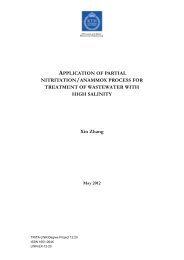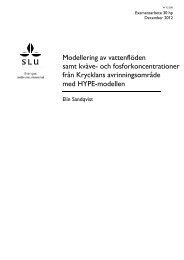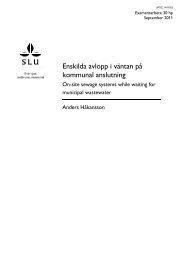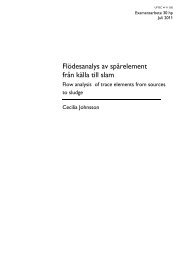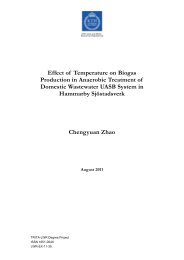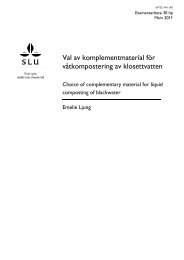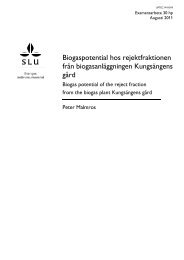Exergy saving and exergy production in municipal wastewater ...
Exergy saving and exergy production in municipal wastewater ...
Exergy saving and exergy production in municipal wastewater ...
Create successful ePaper yourself
Turn your PDF publications into a flip-book with our unique Google optimized e-Paper software.
<strong>Exergy</strong> <strong>sav<strong>in</strong>g</strong> <strong>and</strong> <strong>exergy</strong> <strong>production</strong> <strong>in</strong> <strong>municipal</strong> <strong>wastewater</strong> treatment<br />
membrane of the cell, the more electricity can be achieved from the<br />
oxidation of the material. However if the redox potential of substrate<br />
<strong>and</strong> the anode electrode are too different the metabolism of the bacteria<br />
will be enhanced because the chemical potential which is needed to exist<br />
between the <strong>in</strong>side <strong>and</strong> outside of the membrane is provided by the<br />
anode <strong>in</strong>stead of proton <strong>production</strong> by the cell itself. This leads to lower<br />
maximum atta<strong>in</strong>able voltage by the MFC because there is less need to<br />
produce protons outside the cell membrane of the bacteria.<br />
In order to keep proton <strong>production</strong> of the cell high, the anode potential<br />
should be kept down but not lower than a specific limit because then the<br />
cell will go to fermentation respiration (Logan et al, 2006). The protons<br />
produced <strong>in</strong> the metabolism process are be<strong>in</strong>g used to move the turb<strong>in</strong>e<br />
shape prote<strong>in</strong> which is <strong>in</strong> the membrane of the cell to make ATP from<br />
ADP <strong>and</strong> pi. The electrons will attach to the f<strong>in</strong>al electron acceptors like<br />
for oxygen after pass<strong>in</strong>g through electron transfer cha<strong>in</strong> (which takes<br />
them from a higher energy level to a lower energy level). Though, the<br />
f<strong>in</strong>al product of the respiration is water. This process of water<br />
<strong>production</strong> <strong>in</strong> bio-fuel cell has been taken deliberately to the cathode<br />
compartment. Therefore; the process of ATP <strong>production</strong> is then<br />
<strong>in</strong>terrupted manually. This has led to less <strong>production</strong> of biomass<br />
compar<strong>in</strong>g to aerobic respiration. (Logan et al, 2006)<br />
1.26. How to measure the amount of electricity be<strong>in</strong>g produced:<br />
The half reaction <strong>in</strong> each cell should be used to measure the amount of<br />
produced electricity which is called the electron motive force. Electron<br />
motive force or shows the potential difference between the anode<br />
<strong>and</strong> the cathode can be calculated accord<strong>in</strong>g to equation (Wall, 1977)<br />
which calculates the electron motive force <strong>in</strong> pH=7 as the pH of the<br />
cytoplasm is 7 (Jørgensen, 2001).<br />
E emf = E 0 - [RT/nFln(π)] (57)<br />
E 0= st<strong>and</strong>ard (pH=0) cell electron motive force<br />
R = 8.31447 J/mol-K the gas constant<br />
T = absolute temperature (◦K)<br />
n = number of electrons transferred<br />
F = 96.485 C/mol faraday’s constant<br />
Π = [products] P /[reactants] r (58)<br />
Products = reduced species<br />
Reactants = oxidized species<br />
Oxidized spices + e-→reduced species (59)<br />
If these calculations are done with Gibbs free energy, the follow<strong>in</strong>g will<br />
be <strong>in</strong> use:<br />
∆Gr = ∆Gr 0+RT ln(π) (60)<br />
∆Gr = the Gibbs free energy for the specific conditions (J)<br />
∆Gr 0 = Gibbs free energy under st<strong>and</strong>ard conditions usually 298.15 K, 1<br />
bar pressure <strong>and</strong> 1 M concentration <strong>and</strong> pH=0 for all species<br />
Cell electron motive force is the potential difference between the<br />
cathode <strong>and</strong> anode. The work produced by the cell is calculated<br />
as follows:<br />
W = E 0 Q = -∆Gr 0 (61)<br />
Q = nF (62)<br />
The charged transferred <strong>in</strong> the reaction, expressed <strong>in</strong> coulomb (C) <strong>in</strong><br />
which n is the number of electrons per reaction mol.<br />
25




